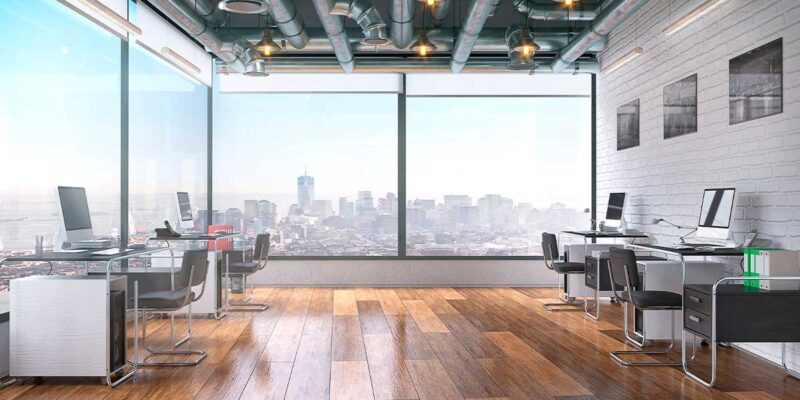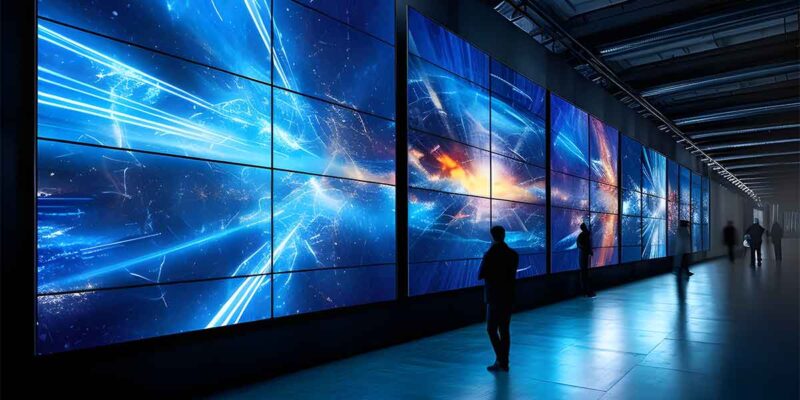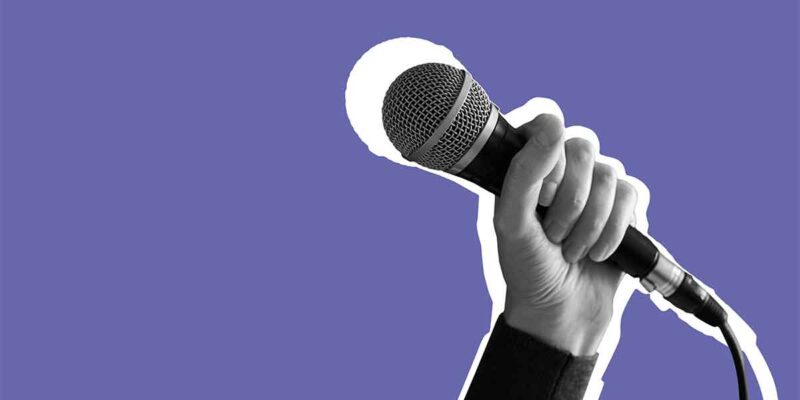Audio Collaborative 2020 — The Blog Version, Pt. 1
By: Steph Beckett & Leah McCann
Wednesday marked the start of the seventh-annual Audio Collaborative conference put on by UK-based Futuresource Consulting. Over two days, the 2020 conference, a virtual version of the show this year, tapped a lineup of industry experts to inspire a listening audience. Who was that audience? AV, technology and IT stakeholders looking at new behaviors in the context of audio innovation — with the end goal to become stronger and ready to capture upon the opportunities to come.
An exciting event for anyone who geeks out about audio, or simply just sells in this space, Audio Collaborative 2020 brought forth some timely questions:
- How is audio evolving, both on the commercial side and business side?
- How can we speak to broader audiences through audio technology?
- What are some of the challenges and opportunities in audio spaces today?
Our coverage of Audio Collaborative 2020, day one, is as follows.
How Technology Is Rapidly Changing Entertainment
After a warm welcome and opening remarks from Sarah Carroll, director at Futuresource Consulting, Geir Skaaden of Xperi took the stage. Later in the session, he was joined by Futuresource’s David Sidebottom. The million-dollar question of this keynote: How is technology changing the entertainment experience?

The conversation around audio is shifting. With people consuming more content in their personal lives, we’re seeing increased investment in audio gear at home, Skaaden said. We’re also seeing, more broadly, a lack of discretionary spending on things like travel, replaced by investments in the home. More families spending time together could mean more investments in hardware (e.g., sound bars in spare bedrooms) and systems (speaker sets in garages) for additional rooms in the house. This benefits the industry and creates an interesting demand pattern.
Are consumers expecting more from their equipment and a better AV experience than before? Sidebottom asked. No question, Skaaden answered. Advancements in AI, voice technologies, smart speakers and more will only continue this demand trend from consumers too. It’ll extend into 2021 and beyond, Skaaden said, as we think about the next generation of products for audio.
The Health of Radio Broadcasting
Audio Collaborative carried on to a panel-packed discussion on radio broadcasting, which has been with us for just over a century — but where is it today? Where is it headed? With headlines increasing along the lines of podcasting, Spotify, and apps, apps and more apps, what’s the health of traditional broadcast radio? asked Jack Wetherill of Futuresource, the session moderator. Where’s it really going?
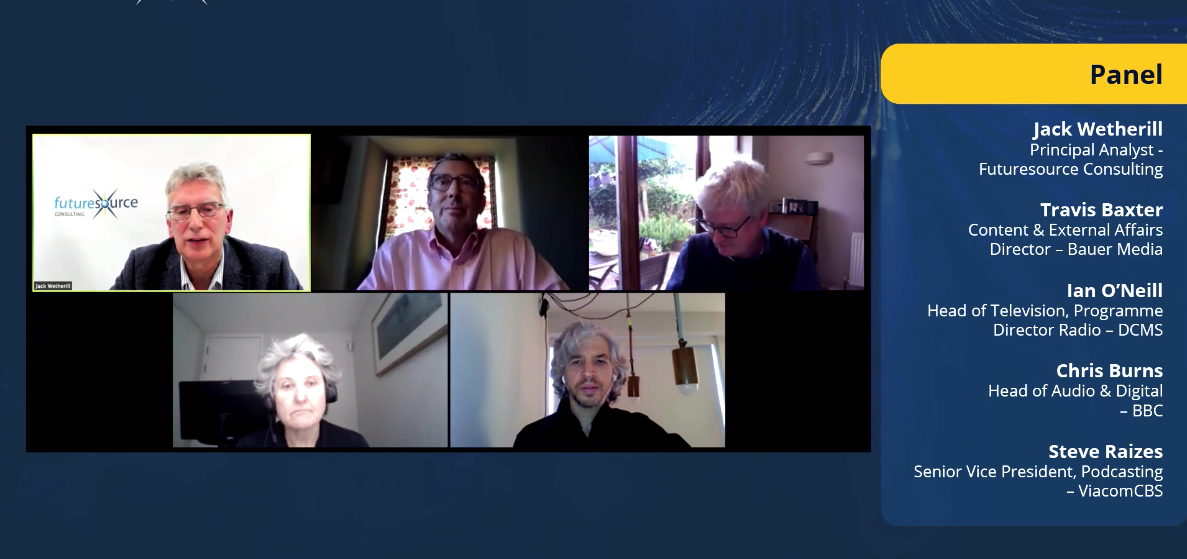
Four panelists came ready to give their perspectives:
- Travis Baxter, Content & External Affairs Director — Bauer Media
- Ian O’Neill, Head of Radio and Head of Broadcasting Resilience — DCMS (Department for Digital, Culture, Media & Sport)
- Chris Burns, Head of Audio & Digital — BBC
- Steve Raizes, Senior Vice President, Podcasting — ViacomCBS
Baxter led that commercial radio is doing brilliantly. Considering the disruption that has taken place over the last 50 years — including the proliferation of other media; the development of the internet; the changing way we’re consuming media — radio has remained a fantastically flexible and fluid, innovative business. Before this year, Baxter continued, radio emerged as a leading element of the audio market (and is expanding at pace). Within the COVID-19 conversation, radio has an opportunity of restating its purpose. It’s related to the way consumers come to radio to get accurate information: Radio provides a sensible, considered view of the world around us.
Audience interaction to all stations has gone up by a third too, Burns said. Why? Because people are seeking contact and companionship during these times. The importance of community — also in a live and local way — is huge surrounding COVID-19 lockdowns, she added.
We’re always trying to bring more people into the medium, Raizes offered. This means, in part, working with growing lines (like podcasting, Spotify, etc.) to collectively grow the audio pie. Raizes sees two big takeaways: One: radio is not dead; there are many opportunities for growth. Two, the power of localization in radio is expanding.
On Podcasting
Moving onto the topic of podcasting, the panel noted that radio and podcasting are two different mediums — with different models, consumers and sales structures. But audio is central to each — and the technology fueling both radio and podcasting (e.g., Bluetooth in cars, etc.) continues to move forward.
With 32 million episodes available in podcast stores, Raizes added, it can be a touch overwhelming for those just coming into the medium. For this, content creators need to think about the importance of runtimes: Some listeners will want short and sweet, while others will seek a full, drawn-out story and longer episodes. Content creators and audio experts need to understand the audience and what their audio product is solving. Fanbase engagement (and getting feedback from listeners) is big in the podcasting world too. Raizes added that successful shows have relationship-based communities around them, which is what makes them so well attended. Podcasts, in essence, build an impressive army of listeners.
Here’s a quick clip of @Futuresourcer #AudioCollaborative2020 panelist @sraizes of @ViacomCBS on the synergy and tensions between radio and podcasting ⬇️
“At the end of the day, audio is audio.” #AVtweeps #AVisLIFE pic.twitter.com/pewUtxgNcv
— rAVe [PUBS] (@rAVePubs) November 4, 2020
Burns challenged how we can make our stories go even further. She talked about the angle of the BBC’s “Make a Difference” podcast and how the world is enjoying the show’s positive stories in a world that currently feels quite bleak. There’s a certain intimacy you can get with a podcast, Burns continued. They’re an opportunity of exposing those stories we have in which people are drawn in — featuring new voices and different experiences of us, as humans, as one.
Of course, there are challenges ahead in the model too. O’Neill said that the shape of the industry will change, but he hopes to see more investment in audio and to see the UK use its skills to develop more opportunities internationally. We’ll see continued consolidation in radio too; but radio will remain a strong and vibrant source of value.
There will also be more consumption and new monetization models, Baxter called out — related to advertising funding, subscriptions and models we haven’t even thought of yet. You will see more mingling of podcasts and radio. Hopefully, he added, there’s a continued synergy between the two mediums that we can lean into — with audio bringing people together through localization and the live element that people love.
Local radio remains important among a strong commercial sector. How we support and sustain local radio in the next five years will be important. But, based on today’s panel discussion, the outlook for commercial radio looks bright.
Key Market Drivers
Hello hello, Steph Beckett here with the other half of this article. I’d like to begin by saying there is no one key driver of an entire market. (Any market really — there are probably exceptions to every rule BUT for all intents and purposes there is not any one thing really driving audio right now. Instead, it’s a few different factors. Anyway — let’s talk about the panel, hosted by Luke Pearce of Futuresource Consulting.
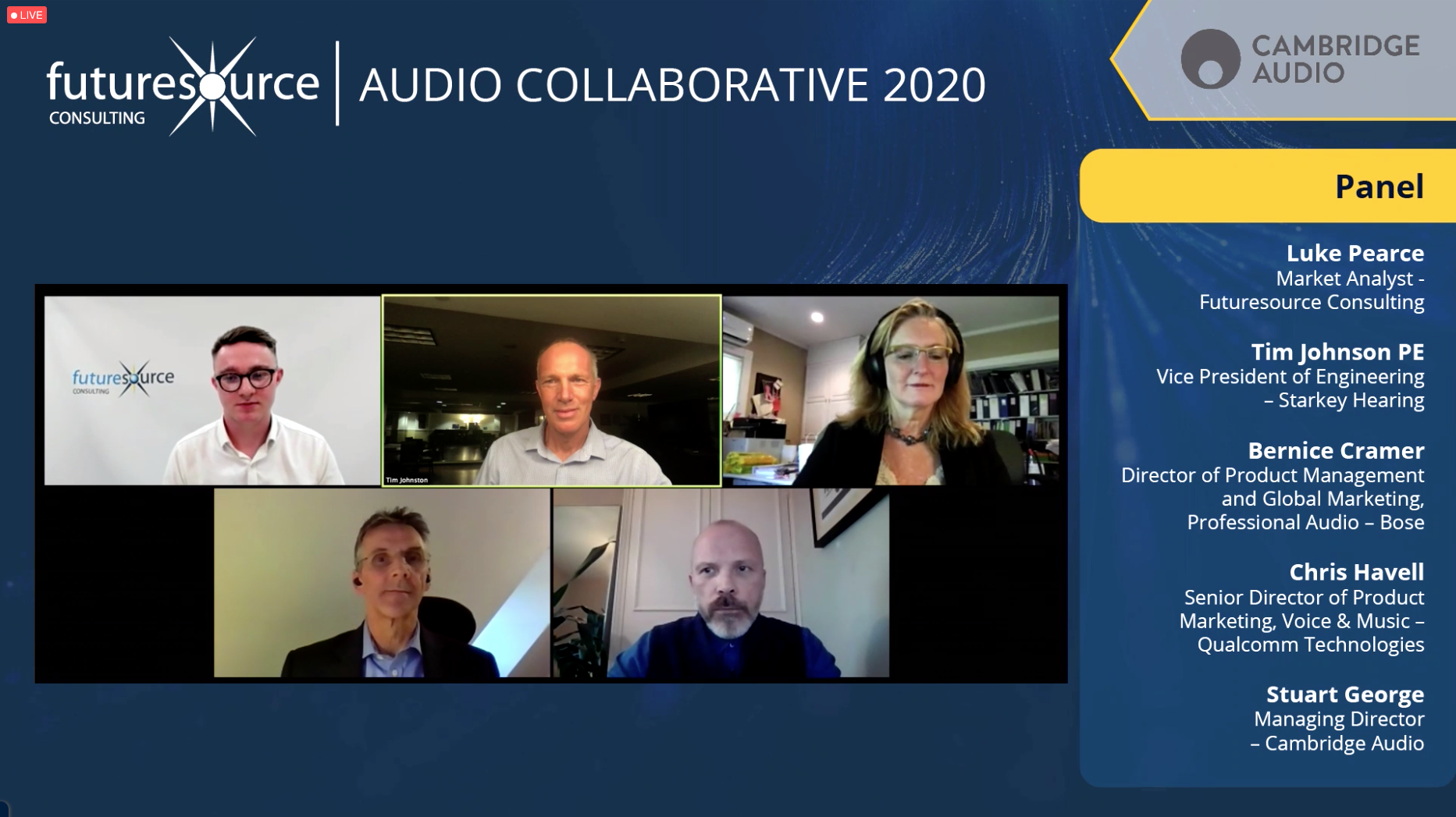
The four panelists were:
- Tim Johnston, Vice President of Engineering — Starkey Hearing
- Bernice Cramer, Director of Product Management and Global Marketing, Professional Audio — Bose
- Chris Havell, Senior Director of Product Marketing, Voice & Music — Qualcomm Technologies
- Stuart George, Managing Director — Cambridge Audio
The conversation started simply — by discussing headphones. We all know what those are. We all use them. Many of us have purchased one (or multiple) new pair(s) during COVID — and it just keeps climbing.
“The single most reliable indicator of whether a consumer will purchase a pair of premium headphones, is whether they already have a pair of premium wireless headphones.” – @BosePro’s Bernice Cramer on the key drivers in the premium headphones market. #AVtweeps @Futuresourcer pic.twitter.com/LqAxtirKwH
— rAVe [PUBS] (@rAVePubs) November 4, 2020
As you can see in the tweet above, Bernice Cramer mentioned that headphones, for more than a few consumers these days — can be like sunglasses. You have different pairs for different things. As a consumer of audio technology, I felt this. I currently own:
- My exercise/garbage earbuds that are on their last legs
- My earbuds with better sound quality that are not on their last legs
- My emergency back-up earbuds
- My audio editing over-ear headphones
- A headset for calls
- I am in the market for AirPods but haven’t quite gotten around to purchasing them yet
I recognize that not everyone is as crazy as I am with the six pairs of headphones but believe me, I felt seen when she said that. Another point she made: As we are moving through COVID — we’re starting to use head-worn devices as an interface with the world.
Final point I’ll make before I move us on to the next session: Tim Johnston had a great point about over-stimulation in the face of COVID, particularly when it comes to sound. Sure, we change out our headphones with what activity we are completing, but we are wearing these devices day in and day out and then are finishing up the day with the speakers (or sound system) in our TVs. What’s the cost of this in the long-term? According to Tim, we don’t know for sure! There is so much sound exposure we are constantly getting — will this mean hearing loss for us all later?
So — to recap: Yes, headphones are all the rage right now. How could they not be? So, in a sense, COVID is driving the market right now. The work-from-home population all needs this technology to function. But, in the future when we are back to whatever, what will the market look like then? I don’t know. I hope we will still all be able to hear.
Consumer Audio Trends
Alright, everybody. I’ll make this next part quick and easy. Guy Hammett, market analyst at Futuresource, gave us some market trends in audio and some things we can expect/look for post-COVID-19.
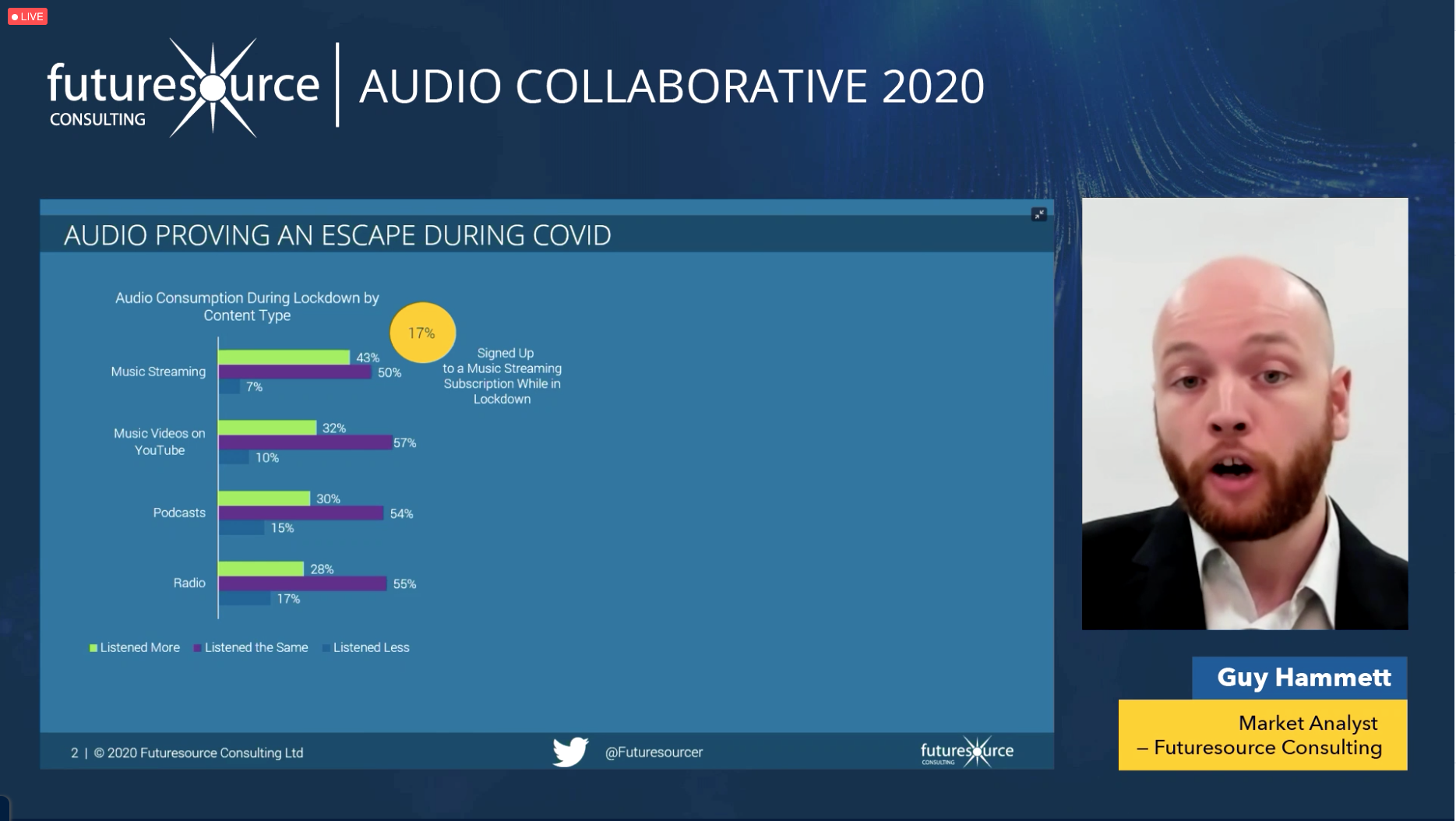
First of all, we can see that 2020 has been a hell year and people are turning to audio for an escape. Can confirm.
People are:
- Listening to more music.
- Subscribing to music subscription services.
- Consuming podcasts.
- Listening to the radio.
There is this desire to fill more time with audio.

Alright next up — headphone market value. With all that sound we are consuming as of late, we have to listen to it with something. And that brings in the growth of true wireless — especially as we’re using that technology for both work and our own personal uses.
I’ll follow up by saying that Guy also mentioned speakers — Wi-Fi speakers are doing well, but their Bluetooth counterparts aren’t doing as well. Which, when you think about it, makes sense. We aren’t really going anywhere right now where we want to take Bluetooth speakers, and Wi-Fi ones just stay at the house, so why not just buy those?
Overall, people have an awareness of premium audio technologies right now — and they are buying in! Will this last? I think on some level. It feeds into the headphone point of my coverage of the panel above, people are wanting different audio technologies to do different things right now. As with all things, we could see it slow down, but it’s doubtful that it will just go away.
But then again, I’m not a market analyst. That’s Guy’s job. And from my understanding, while home cinema technology doesn’t have much penetration around the world, he says premium audio technologies like speakers and true wireless headphones will continue to be purchased if they’re relatively affordable and accessible.
Recaps & Takeaways
Day one of Audio Collaborative 2020 offered a fresh set of insights and content themes around where audio is headed. Some of the themes discussed Wednesday:
- More people are spending money on personal and home entertainment audio equipment
- A vast majority of people, 80%, report that music has the ability to influence their mood
- Our hearing deteriorates as we grow older, but what audio can do is achieve an immersive experience so people can enjoy the content as it should be heard, personalized to their hearing; innovations in audio-enhancement technology (like in earbuds and headsets) are exciting and growing
Thanks for reading our wrapup! The archived content for Audio Collaborative 2020 will be available for an additional six months. Register for Audio Collaborative 2020 here. Also, as seen in the tweets above, you can look at all the live coverage from this event by searching “#AudioCollaborative2020” on social media. Keep an eye out for coverage of Day Two!


